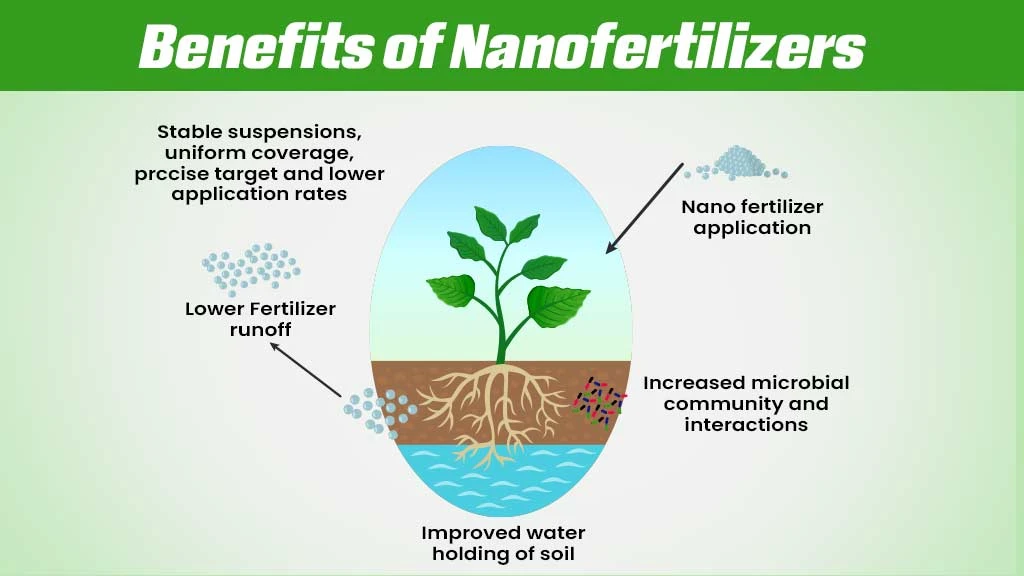Nanofertilizers in India: An Alternative and Sustainable Method of Fertilizing Crops

Table of Contents
- Introduction
- What are Nanofertilizers?
- What are Different Types of Nano Fertilizers in India?
- What is the Need to Use Nanofertilizers in Agriculture?
- What are the Nanofertilizers Benefits over Conventional Fertilizers?
- Are Nanofertilizers Environment Friendly?
- How Government is Promoting the Adoption of Nanofertilizers?
Introduction
Fertilizers are important for the optimum growth of plants. They have been the mainstay of modern farming methods worldwide, including India, since the beginning of Green Revolution in 1960s.
Over the years, the use of fertilizers, especially chemical fertilizers, have brought a vast increase in the agricultural productivity, and consequentially, providing food security to millions in India.
However, the overuse of it has harmed the environment by decreasing the soil health and has impacted the human health due to presence of fertilizer residues in crops we consume.
In this light, the Indian government has been now increasingly emphasising on adoption of alternative methods of providing nutrients to soil and crops so as to make the agriculture more sustainable.
Some of the examples are promotion of organic farming, and use of bio-fertilizers. The latest in these initiatives are the promotion and adoption of nanofertilizers in India.
So, lets us understand the meaning, importance and benefits of nano fertilizers in India and what steps the government of India has taken to promote it in below paragraphs.
What are Nanofertilizers?
Nanofertilizers are an innovative and new generation of fertilizers that uses advance nanotechnology to release the nutrients in the soil in controlled manner for an extended period of time to achieve efficiency in application and cost. Nano fertilizers contain nano sized particles of less than 100 nanometer that are easily absorbed by crops resulting in improvement in crop yield.
Some of the nano materials used in the production of nano fertilizers are carbon nanontubes, quantum dots and graphene. These nanomaterials are naturally occurring and they are found in various sources such as ocean, volcanic ash, and biological matters such as dust and viruses.
Nanofertilizers through the controlled-release mechanism scores big over traditional fertilizers. It is because, on the one hand, it minimises the need for frequent fertilizers, and on the other, it ensures sustained supply of essential nutrients to the crop for an extended period of time. Thus, nano fertilizers are efficient and sustainable method of fertilizing agricultural crops.
What are the Different Types of Nano Fertilizers in India?
Nanofertilizers can be classified on the basis of their actions, consistency and nutrient composition. See the classification below:
Action Based Nanofertilizers
- Controlled release
- Targeted delivery
- Plant growth stimulating
- Water & nutrient loss controlling
Nutrient Based Nanofertilizers
- Inorganic
- Organic
- Hybrid
- Nutrient-loaded
Consistency Based Nanofertilizers
- Surface coated
- Synthetic polymer coated
- Biological product coated
- Nanocarrier based
In India, essentially two types of nanofertilizers are used. These are:
- Nano Urea (Liquid): This fertilizer has nanoparticles of size 20 – 50 nm and have more surface area and number of particles. As a result, 80% of it is available to plants resulting in higher nutrient use efficiency.
- Nano DAP (Liquid): It is an efficient nanofertilizer containing Nitrogen (N) and Phosphorus (P) in 8% and 16%, respectively. Its nanoparticles are of size less than 100 nm.
What is the Need to Use Nanofertilizers in Agriculture?
The population of India has crossed 140 crores mark and with this the need to feed millions have become a challenging task. This calls for increasing the production of food crops in agriculture. As a result, the farmers are forced to use traditional fertilizers to increase the crop yield. But the overuse of chemical fertilisers in modern farming methods have led to decline in soil fertility. As per some estimates, the overuse has led to loss of essential nutrients (N, P and K) from soil to the extent of 50 – 80%.
Furthermore, India is one of the leading agricultural countries in the world, where more than 54% area is classified as arable. Also, more than 55% population is dependent upon agriculture for their livelihood and agriculture contributes more than 18% to the India’s GDP.
In the above light, therefore, it is important to promote the use of environment-friendly nanofertilizers to make agriculture sustainable and ensure food security for all.
What are the Nanofertilizers Benefits Over Conventional Fertilizers?

Substantial Increase in Crop Yields
Application of nanofertilizers have shown to increase the crop yields substantially. The timely and precise application of fertilizers to the crops ensure that they receive essential nutrients at the right time and in right quantity. As a result, crops grow healthier boosting overall yield.
Cost Saving in Long Run
Nano fertilizers may initially seem to be an expensive investment. But the sustained supply of nutrients to plants for a longer period of time, higher nutrient absorption and reduced wastage make them highly cost saving and viable in the long run for the farmers.
Reduction in Soil & Water Contamination
Nano fertilizers minimize the negative impact of agriculture on environment caused by overuse of chemical fertilizers. This is because they release the nutrients gradually and directly to the roots of the plants. Also, they reduce the overuse of chemical fertilizers, and in turn, reduces the risk of soil & water contamination. The net result is the healthy soil and sustainable agriculture.
Increase in Water Retention Capacity of Crops
Water scarcity during drought season is common in India due to its tropical climate. This affects agricultural productivity. The application of nano fertilizers become critical in these conditions as they help improve water retention capacity of the farm crops. As a result, crops become more resilient during droughts.
Improved Nutrient Absorption
The application of conventional fertilizers causes leaching or volatilisation of soil leading to loss of nutrients. But with nanofertilizers this is addressed because these innovative fertilizers improve the nutrient absorption capacity of plants. As a result, the growth potential of crops is maximised resulting in increase in crop yields.
Are Nanofertilizers Environment Friendly?
Nanofertilizers are non-toxic and are considered relatively more friendly to human health and environment compared to chemical fertilizers. Some of the benefits of its applications includes:
- They help increase soil fertility.
- They significantly reduce loss of soil nutrients.
- They also help improve nutrient use efficiency.
- They help minimise degradation of soil due to their controlled release system.
However, their long-term impact on environment is still a subject of research, although some researches have raised concerns regarding their toxicity, safety and regulation.
How Government is Promoting the Adoption of Nanofertilizers?
Realising the benefits of nanofertilizers to agricultural sustainability, food security and cost-effectiveness, the Government of India notified the Nano Urea and Nano DAP under Fertilizer Control Order, 1985. As a result, four Nano DAP plants and six Nano Urea plants with an annual capacity of 10.74 crores bottles and 26.62 crore bottles, respectively, have been established in the country.
In addition to the above, following steps have been taken by the government to promote the adoption of Nano fertilizers by farmers:
- Conducting awareness camps, regional language films, nukkad nataks, Kisan Sammelans and other such activities.
- Making Nano Urea available at the Pradhan Mantri Kisan Samridhi Kendras (PMKSKs) by nanofertilizer producing companies.
- Including Nano Urea under monthly supply plan of Department of Fertilizers on frequent basis.
- Using Kisan Drones under “Namo Drone Didi Scheme” to increase the application of nano fertilizers.
- Initiation of Maha Abhiyan by the Department of Fertilizer to increase the adoption of Nano DAP in 15 agro-climatic zones of India.


Related Blogs












